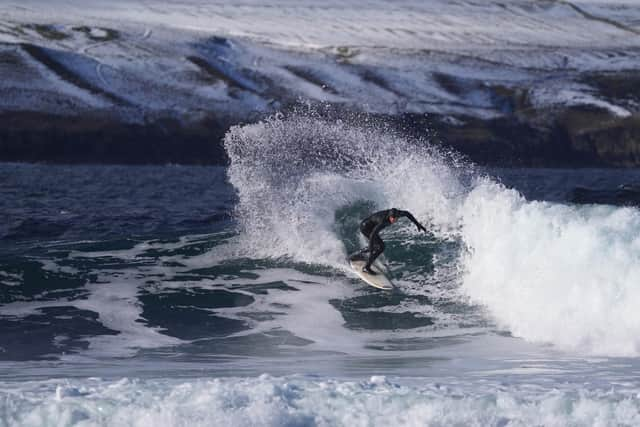Eurosurf: Scotland’s best surfers to compete at one of Portugal's literary hotspots
Even by Portuguese standards, the stretch of beach beside the town of Santa Cruz, about a 90 minute drive to the north of Lisbon, is something special. With its towering cliffs and unusual rock formations – including a huge, distinctive, Salvador Dalí-esque sea arch which appears to be in the process of toppling over – it has a wild, rugged, somewhat haunted feel.
The beauty and otherworldliness of the place have fired the imaginations of various notable writers over the years, including the celebrated Portuguese poet and philosopher Antero de Quental, who visited in the summer of 1870. Somehow, in between swimming in the sea and strolling along the shore, he managed to find time to translate Goethe's Faust into verse and write a series of sonnets.
Advertisement
Hide AdAdvertisement
Hide AdA century later, in 1970, the Japanese war correspondent, novelist and poet Kazuo Dan came to Santa Cruz, looking for a place where he could, as he put it, “have a conversation with heaven and earth.”


Dan found it such an ideal spot for communing with the elements that he ended up staying for 16 months, taking his puppy for walks on the beach and writing his novel House on Fire, which was subsequently made into a film by Kinji Fukasaku. He now has a street named after him, and also an octopus dish – "Octopus à la Kazuo Dan" – at a cafe he used to frequent.
In 2016 a poets' trail – Passeio dos Poetas – was opened, allowing visitors to retrace the writers' footsteps and visit some of the locations that inspired them. A statue of de Quental sitting on a bench, lost in thought, with plenty of space left to sit down beside him, provides a popular photo op.
From 20 June, however, any literature lovers visiting the area will be joined by a very different breed of pilgrims, as many of the best surfers in Europe gather in Santa Cruz to take part in this year's Eurosurf contest.
Hosted by the European Surfing Federation, this biennial competition brings together national teams of waveriders from all over the continent to compete in both shortboard and longboard divisions. Based on the results in this year's Scottish National Surfing Championships, Team Scotland will consist of Craig McLachlan, Mark Boyd and Mark Cameron in the men's shortboard; Phoebe Strachan, Clover Christopherson and Olivia MacKay in the women's shortboard; Sam Christopherson in the men's longboard; and Strachan again in the women's longboard.
This year's Scottish Nationals were held at Brims Ness, a fast, hollow reef break just to the west of Thurso, in characteristically punchy conditions, and Scotland's top surfers typically excel in exactly these kinds of waves. As a result, their fortunes in international contests tend to improve in line with the size and quality of the surf.
In small, underpowered beachbreak waves in the south of France a few years ago, for example, Team Scotland seemed to struggle to generate much in the way of forward momentum; send them out in heaving double-overhead barrels, however, and they are more than capable of going toe to toe with the best of the best from Europe’s more established surfing nations.
After bagging his place in the Scotland team with a win in the men's open division at the Scottish National Surfing Championships back in the spring, I asked 17-year-old Craig McLachlan what he was expecting in Portugal.
Advertisement
Hide AdAdvertisement
Hide Ad“It’s kinda hard to say what the waves will be like,” he replied. “It could be absolutely huge or it could be tiny.”
That certainly seems to be the view from surf forecasting site Surfline. Santa Cruz, it says, "is home to... a long stretch of sand that produces some thumping barrels and reeling peaks that can rival Europe's best on its day."
The optimal season for powerful, long-interval groundswell, however, is the autumn. In July, according to another surf forecasting site, surf-forecast.com, the waves are usually four feet or smaller for more than 90 per cent of the time.
Still, as McLachlan says, when it comes to the ocean, anything can happen: Santa Cruz is exposed to the full force of the Atlantic, so if a significant storm system happens to develop during the contest period, then the contest organisers – and potentially Team Scotland – could reap the benefits.
Not that bigger waves won’t make life challenging. The Surfline spot guide also notes that, when it gets big here, there are “plenty of currents moving around and some arm-draining rips.” Still, Scotland’s finest spend their winters tackling all that and more in sub-zero temperatures. At least nobody will be getting hypothermia in Portugal.
Eurosurf 2023 is at Santa Cruz, Portugal, from 20-28 July, see https://www.eurosurfing.org/
To support the surfers representing Scotland at Eurosurf, visit http://thessf.com
